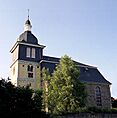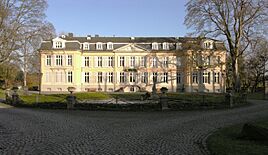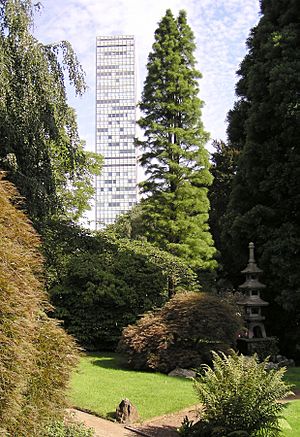Leverkusen facts for kids
Quick facts for kids
Leverkusen
|
|||
|---|---|---|---|
|
Chempark
BayArena
Bayer headquarters
Bergisch Neukirchen's old town
Houses in Wiesdorf´s Gründerzeit old town
Morsbroich Museum
|
|||
|
|||
| Country | Germany | ||
| State | North Rhine-Westphalia | ||
| Admin. region | Köln | ||
| District | Urban district | ||
| Elevation | 60 m (200 ft) | ||
| Population
(2022-12-31)
|
|||
| • Total | 165,748 | ||
| Time zone | CET/CEST (UTC+1/+2) | ||
| Dialling codes | 0214, 02171 & 02173 | ||
| Vehicle registration | LEV and OP | ||
| Website | www.leverkusen.de | ||
Leverkusen is a city in Germany, located in the state of North Rhine-Westphalia. It sits on the eastern side of the Rhine River. To the south, it's close to the big city of Cologne. To the north, it's near Düsseldorf, the state capital. Leverkusen is part of the Rhine-Ruhr Metropolitan Region, which is one of Europe's largest urban areas.
With about 163,000 people, Leverkusen is one of the state's smaller cities. The city is famous for the pharmaceutical company Bayer. It is also known for its sports club, Bayer 04 Leverkusen.
Contents
Discovering Leverkusen's Past
The area that is now Leverkusen began as a village called Wiesdorf. This village was first mentioned in the 12th century. It was located right on the Rhine River. The region also includes the Wupper and Dhünn rivers.
Early Challenges and Growth
The area faced many floods over the centuries. Big floods happened in 1571 and 1657. The 1657 flood caused Wiesdorf to move further east from the river. During the Cologne War (1583-1588), Leverkusen was greatly affected by the fighting. Until the late 1800s, the area was mostly farmland.
How Leverkusen Became an Industrial Hub
Industry started to grow in the late 19th century. This growth led to the development of the city we know today. Leverkusen became a very important center for Germany's chemical industry.
In 1860, a chemist named Carl Leverkus chose Wiesdorf for his new dye factory. He built a factory there in 1861 to make artificial ultramarine blue. He named the growing settlement "Leverkusen" after his family home. The Bayer company took over this factory in 1891. Bayer moved its main offices to Wiesdorf in 1912.
Forming the City of Leverkusen
The city of Leverkusen was officially created in 1930. This happened by combining Wiesdorf with other nearby villages. These included Schlebusch, Steinbüchel, and Rheindorf. The city was named after Carl Leverkus, honoring his contribution.
During the Second World War, the factories in Leverkusen were bombed. This happened several times in 1943. In 1975, more towns joined Leverkusen. These included Opladen, Hitdorf, and Bergisch Neukirchen. Today's city is made up of many former villages.
In 2021, an industrial incident occurred at the Chempark site in the city.
Leverkusen's Population Over Time
The number of people living in Leverkusen has changed a lot over the years. Here's how the population has grown since 1832:
| Historical population | ||
|---|---|---|
| Year | Pop. | ±% |
| 1832 | 11,442 | — |
| 1871 | 15,507 | +35.5% |
| 1900 | 24,974 | +61.0% |
| 1910 | 44,088 | +76.5% |
| 1925 | 61,404 | +39.3% |
| 1933 | 67,260 | +9.5% |
| 1939 | 75,171 | +11.8% |
| 1946 | 84,646 | +12.6% |
| 1950 | 98,867 | +16.8% |
| 1961 | 137,516 | +39.1% |
| 1970 | 161,808 | +17.7% |
| 1987 | 154,692 | −4.4% |
| 2000 | 161,426 | +4.4% |
| 2010 | 161,132 | −0.2% |
| 2017 | 166,737 | +3.5% |
Understanding Leverkusen's Coat of Arms
The city's coat of arms has a red lion with two tails. This lion is standing up on its hind legs. It wears a blue crown. The background is silver. There is also a special zig-zag line in front of the lion. This design represents the Bergisches Land region.
Exploring Main Sights and Attractions
Leverkusen offers many interesting places to visit. From sports stadiums to beautiful gardens, there's something for everyone.
- BayArena is the home stadium for the Bayer Leverkusen football team. It can hold over 30,000 fans.
- The Bayer Cross Leverkusen is a huge illuminated sign. It is one of the largest lighted advertisements in the world.
- Freudenthaler Sensenhammer is a museum about industry. It shows how things were made in the past.
- Schloss Morsbroich is a beautiful Baroque-style castle surrounded by a moat. Today, it is a museum for modern art.
- Water Tower Leverkusen-Bürrig is a tall water tower. It is about 72 meters (237 feet) high. It also has a viewing deck where you can see great views.
- Neuland Park is a large park located next to the Rhine River. It's a great place for outdoor activities.
- Japanese Garden was first created in 1913. Carl Duisberg expanded it in 1923. It's a peaceful and beautiful garden.
- The Colony of Workers is a historic area. It has houses and buildings built for factory workers and their families. These were built in the late 1800s and early 1900s.
- Einigkeit und Recht und Freiheit is a historic boat bridge. It crosses the Rhine between Wiesdorf and Rheindorf.
- Mausoleum of Carl Duisberg is a special tomb. It is located in the middle of the Carl Duisberg Park, near the Casino.
- NaturGut Ophoven is an educational center. It teaches about nature in Leverkusen-Opladen.
Sports in Leverkusen
Leverkusen is well-known for its sports teams. The city is home to the famous football team Bayer 04 Leverkusen. They recently won their first Bundesliga title in the 2023–24 season.
The city also has a strong basketball team, Bayer Giants Leverkusen. This team holds the German record for national basketball championships. As of 2019, they play in the German ProA league. Their home games are played in the Ostermann-Arena. The Ostermann-Arena has also hosted big events. It was one of the arenas for the FIBA EuroBasket 1985 (the official European Basketball Championship).
Connecting with Other Cities: Twin Towns
Leverkusen has special connections with other cities around the world. These are called "twin towns" or "sister cities." They work together on cultural and educational projects.
 Oulu, Finland (1968)
Oulu, Finland (1968) Bracknell, United Kingdom (1975)
Bracknell, United Kingdom (1975) Ljubljana, Slovenia (1979)
Ljubljana, Slovenia (1979) Nof HaGalil, Israel (1980)
Nof HaGalil, Israel (1980) Chinandega, Nicaragua (1986)
Chinandega, Nicaragua (1986) Schwedt, Germany (1989)
Schwedt, Germany (1989) Racibórz, Poland (2002)
Racibórz, Poland (2002) Villeneuve d'Ascq, France (2005)
Villeneuve d'Ascq, France (2005) Wuxi, China (2014)
Wuxi, China (2014)
Famous People from Leverkusen
Many notable people have come from Leverkusen. Here are a few:
- Lothar Rohde (1906–1985), a scientist who founded a company called Rohde & Schwarz Messtechnik.
- Heinrich Lützenkirchen (1909–1986), who served as the mayor of Leverkusen.
- Paul Janes (1912–1987), a well-known footballer.
- Wolf Vostell (1932–1988), a talented sculptor, painter, and artist.
- Ileana Jacket (born 1947), a telenovela actress.
- Bärbel Dieckmann (born 1949), a politician who was the mayor of Bonn from 1994 to 2009.
- Wilfried Schmickler (born 1954), a popular comedian.
- Andreas Hedwig (born 1959), an archivist who works with historical records.
- Dietmar Mögenburg (born 1961), an athlete.
- Detlef Schrempf (born 1963), a famous basketball player.
- Sabine Moussier (born 1966), a Mexican telenovela actress.
- Uta Briesewitz (born 1967), a cinematographer who works behind the camera for films.
- Ralf Schmitz (born 1974), an actor and comedian.
- Jörg Bergmeister (born 1976), a racing driver.
- Ji-In Cho (born 1976), a heavy metal singer.
- Danny Ecker (born 1977), a pole vaulter.
- Felix Sturm (born 1979), a middleweight boxer.
See also
 In Spanish: Leverkusen para niños
In Spanish: Leverkusen para niños










